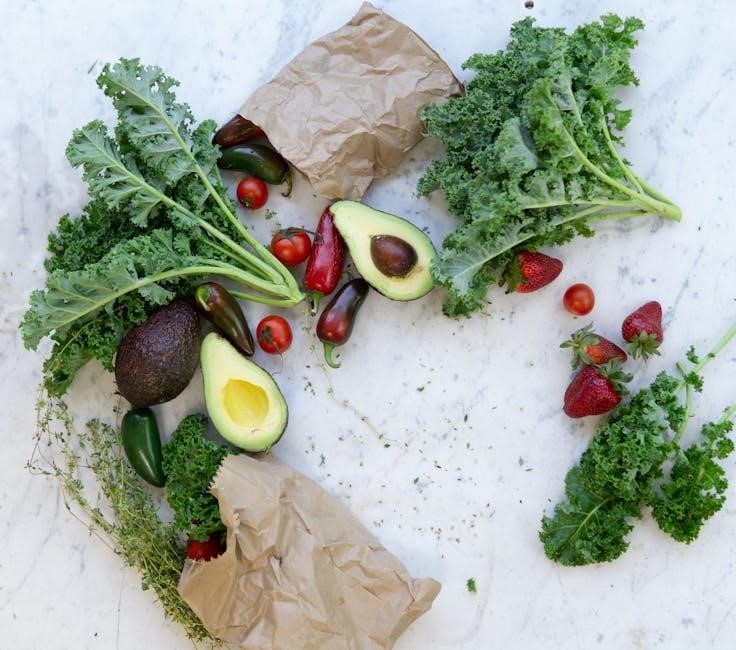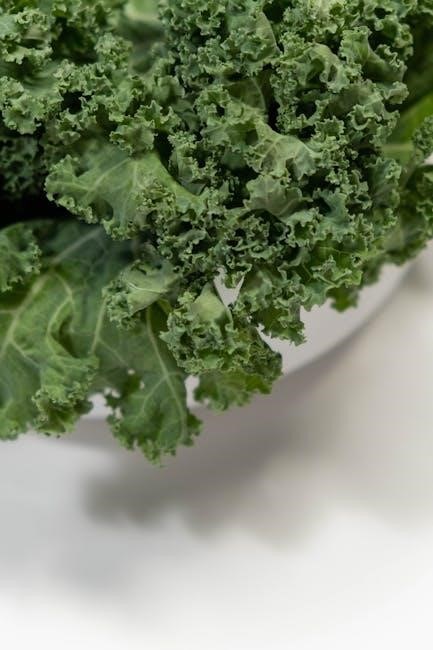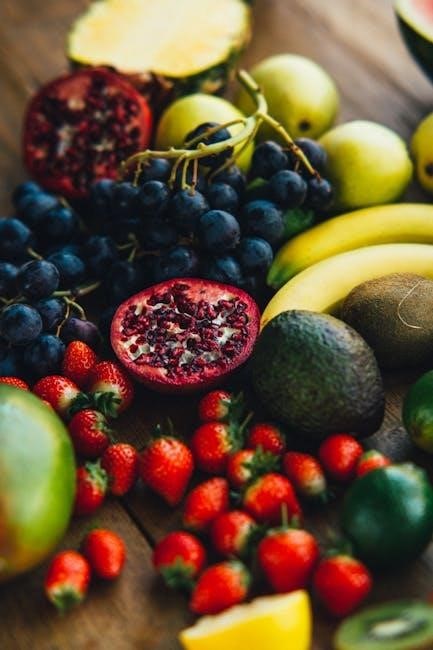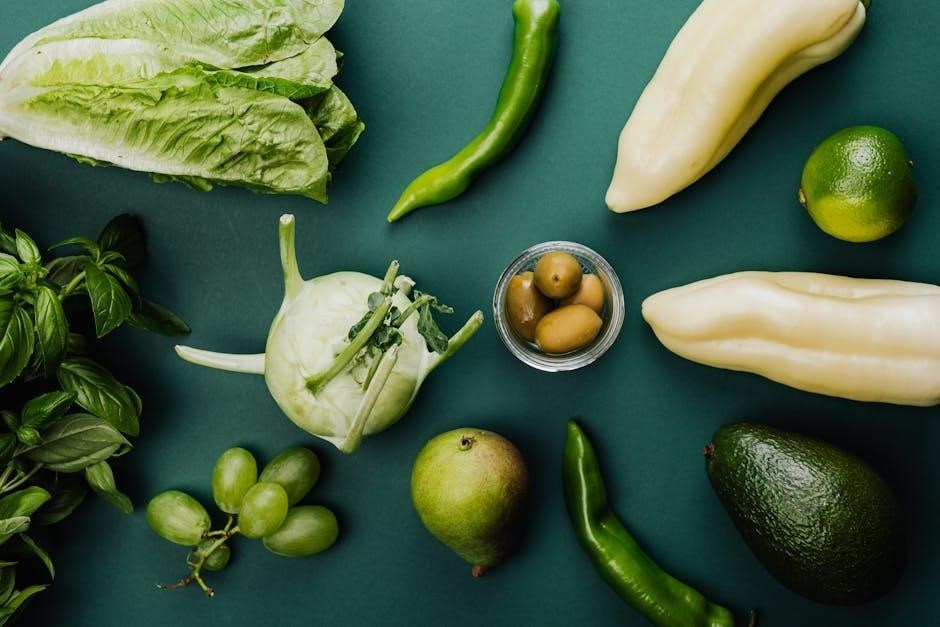A low purine diet focuses on reducing uric acid production by limiting foods rich in purines, which can trigger gout attacks and inflammation․ It emphasizes eating foods low in purines, such as fruits, vegetables, and whole grains, while avoiding high-purine foods like red meat and seafood․ This dietary approach helps manage gout symptoms, lower uric acid levels, and improve overall health․ Adopting a low purine diet is a key strategy for preventing gout flare-ups and maintaining long-term well-being․
What is a Low Purine Diet?
A low purine diet is a dietary plan designed to reduce uric acid production by limiting foods rich in purines․ Purines are compounds found in certain foods that the body breaks down into uric acid․ This diet focuses on consuming foods with low purine content, such as fruits, vegetables, whole grains, and low-fat dairy products, while avoiding high-purine foods like red meat, seafood, and alcohol․ It helps manage gout, prevent flare-ups, and improve overall health by maintaining balanced uric acid levels․

Why is it Important for Managing Gout and Uric Acid Levels?
A low purine diet is crucial for managing gout, as high uric acid levels can cause painful attacks․ By reducing purine intake, the body produces less uric acid, minimizing crystal buildup․ This approach helps alleviate gout symptoms, prevents future flare-ups, and supports overall joint health․ Lowering uric acid levels also reduces the risk of complications like kidney stones, making this diet a cornerstone of gout management and a key strategy for improving quality of life for those affected․

Understanding Purines and Uric Acid
Purines are compounds found in various foods and the body, breaking down into uric acid․ Elevated uric acid levels can lead to gout and other health issues․
What Are Purines?
Purines are naturally occurring compounds found in both the human body and various foods․ They are essential for DNA synthesis and energy production․ However, when purines are broken down, they form uric acid․ Foods like red meat, seafood, and certain alcoholic beverages contain high levels of purines, which can increase uric acid levels in the body․
How Purines Relate to Uric Acid Production
Purines are metabolized into uric acid, a natural waste product typically excreted by the kidneys; When purine intake is high, the body produces more uric acid․ Excess uric acid can accumulate, leading to hyperuricemia, which is linked to gout․ A diet low in purines helps reduce uric acid levels, minimizing the risk of gout attacks and related health issues․
The Role of Uric Acid in Gout and Other Health Conditions
Uric acid plays a central role in gout, as high levels can crystallize and deposit in joints, causing inflammation and pain․ Elevated uric acid is also linked to conditions like kidney stones and certain cardiovascular diseases․ Managing uric acid levels through a low purine diet is crucial for reducing gout symptoms and preventing complications․ Lowering uric acid not only alleviates gout discomfort but also supports overall health by minimizing the risk of associated ailments․

Benefits of a Low Purine Diet
A low purine diet reduces gout attacks by lowering uric acid levels, minimizing inflammation, and improving overall health, making it a crucial strategy for managing gout effectively․
Reducing Gout Attacks
A low purine diet plays a significant role in minimizing gout attacks by reducing uric acid levels, which are often elevated in people with gout․ High purine foods, such as red meat and seafood, can increase uric acid production, leading to painful flare-ups․ By focusing on low purine options like dairy, fruits, vegetables, and whole grains, individuals can lower their uric acid levels and reduce the frequency and severity of gout attacks․ Staying hydrated and maintaining a healthy weight further support this process, helping to alleviate symptoms and improve overall well-being․
Lowering Uric Acid Levels
A low purine diet helps reduce uric acid levels by minimizing the intake of purine-rich foods, which the body converts into uric acid․ High purine foods, such as organ meats and certain seafood, can increase uric acid production, potentially leading to hyperuricemia․ By focusing on low purine options like vegetables, fruits, and whole grains, individuals can lower their uric acid levels and reduce the risk of gout and related conditions․ Proper hydration also aids in flushing out uric acid, supporting overall health and well-being․
Improving Overall Health
A low purine diet not only helps manage gout but also promotes overall health by encouraging balanced eating habits․ It emphasizes whole, nutrient-rich foods like fruits, vegetables, and whole grains, which provide essential vitamins and minerals․ This dietary approach supports weight management, improves heart health, and reduces inflammation․ By focusing on healthy, low-purine options, individuals can enhance their overall well-being while minimizing the risk of chronic conditions associated with excessive uric acid levels and poor dietary choices․

Foods to Avoid on a Low Purine Diet
High-purine foods, such as red meat, seafood, and alcohol, can increase uric acid levels and trigger gout attacks․ Processed foods and sugary beverages should also be limited to reduce inflammation and support overall health․
High Purine Foods
High-purine foods include red meats like beef and lamb, certain seafood such as mussels and anchovies, and organ meats like liver․ These foods can significantly increase uric acid levels, raising the risk of gout attacks․ Alcohol, especially beer and hard liquor, is also high in purines and should be avoided․ Processed and high-fat foods contribute to inflammation and worsen gout symptoms․ Limiting these items is crucial for managing uric acid and reducing gout flare-ups effectively․
Foods That Trigger Gout Attacks
Certain foods can trigger gout attacks by rapidly increasing uric acid levels․ Red meat, seafood, and alcohol are common culprits․ Processed meats like sausages and bacon, as well as sugary drinks, also contribute․ Even some seemingly healthy options, like asparagus and mushrooms, are high in purines and can cause flare-ups․ Identifying and avoiding these triggers is essential for managing gout effectively and preventing painful episodes․ A personalized diet plan can help individuals identify their specific triggers and maintain better control over symptoms․
Alcohol and Its Impact on Uric Acid
Alcohol can significantly increase uric acid levels, worsening gout symptoms․ Beer and hard liquor are particularly high in purines, while spirits like vodka and gin may have lower purine content․ However, excessive alcohol consumption can still trigger gout attacks by raising uric acid production․ To manage gout effectively, it is recommended to minimize or avoid alcohol intake, especially beer and sweetened alcoholic beverages․ Moderation is key, and consulting a healthcare provider can help determine safe alcohol limits for individual circumstances․

Foods to Include on a Low Purine Diet
Foods to include on a low purine diet are low-fat dairy, fruits, vegetables, whole grains, nuts, and eggs, which help manage uric acid and improve overall health․
Low Purine Food Options
Low purine food options include fresh fruits like berries, citrus fruits, and apples, which are rich in antioxidants and fiber․ Vegetables such as spinach, carrots, and bell peppers are also excellent choices․ Whole grains like brown rice, quinoa, and oats provide sustained energy without increasing uric acid levels․ Nuts and seeds, such as almonds and sunflower seeds, are healthy snacks․ Eggs, low-fat dairy products, and lean proteins like chicken and turkey are also recommended for a balanced diet․

Dairy Products and Their Benefits
Dairy products like milk, cheese, and yogurt are excellent additions to a low purine diet․ They are rich in calcium and low in purines, making them ideal for managing uric acid levels․ These foods help reduce the risk of gout attacks and support overall bone health․ Additionally, dairy products can aid in weight management, which is crucial for maintaining healthy uric acid levels․ Incorporating them into your diet promotes a balanced and nutritious meal plan․
Fruits, Vegetables, and Whole Grains
Fruits, vegetables, and whole grains are cornerstone components of a low purine diet․ They are naturally low in purines and rich in essential nutrients, making them ideal for reducing uric acid levels․ Berries, citrus fruits, and leafy greens are excellent choices, while whole grains like brown rice, oats, and quinoa provide sustained energy․ These foods also offer antioxidants and fiber, promoting overall health and aiding in weight management, which further helps control uric acid production and minimize gout symptoms effectively․

Practical Tips for Following a Low Purine Diet
Plan meals around low-purine foods, balance protein intake, and stay hydrated․ Gradual weight loss and mindful eating can help maintain uric acid levels and overall health effectively․
Meal Planning and Grocery Shopping
Plan meals in advance to avoid high-purine foods and focus on fresh, low-purine ingredients․ Shop for fruits, vegetables, whole grains, and lean proteins like poultry and fish․ Incorporate low-fat dairy, nuts, and seeds for variety․ Read food labels to avoid hidden purines and high-sodium additives․ Stock up on staples like brown rice, quinoa, and oats for easy meal preparation․ Prioritize fresh produce and avoid processed or canned goods to maintain a balanced and gout-friendly diet․
Weight Management and Uric Acid Levels
Maintaining a healthy weight is crucial for managing uric acid levels, as excess body fat can increase uric acid production․ Obesity is linked to higher uric acid levels, worsening gout symptoms․ A low-purine diet, combined with regular physical activity, helps achieve and maintain a healthy weight․ Even modest weight loss can significantly lower uric acid levels and reduce gout flare-ups․ Incorporating low-purine foods and avoiding overeating supports both weight management and overall uric acid control, promoting better health outcomes for individuals with gout․
Hydration and Fluid Intake
Proper hydration is essential for managing uric acid levels and preventing gout attacks․ Drinking plenty of water helps flush out uric acid, reducing its buildup in the body․ Aim for at least eight glasses of fluid daily, with water being the primary choice․ Avoid sugary drinks and alcohol, which can dehydrate and increase uric acid levels․ Staying hydrated supports kidney function, aiding in the excretion of uric acid and lowering the risk of gout flare-ups․ Hydration is a cornerstone of a low-purine lifestyle․

Creating a Low Purine Diet Plan
A low purine diet plan involves identifying and avoiding high-purine foods, setting realistic dietary goals, and incorporating nutrient-rich, low-purine alternatives to manage uric acid levels effectively․
Sample Meal Ideas
Start with oatmeal topped with fresh berries for breakfast․ For lunch, try grilled chicken with steamed vegetables like spinach and carrots․ A quinoa salad with cucumbers, tomatoes, and a lemon vinaigrette makes a great dinner․ Snack on apples or celery sticks with almond butter․ Incorporate low-fat dairy like yogurt or milk to enhance meals․ Avoid high-purine foods and opt for whole grains, fruits, and vegetables․ Stay hydrated with water and limit alcohol intake to support uric acid management and overall health․
How to Track Purine Intake
To effectively track purine intake, keep a food diary or use a dietary app to monitor daily consumption․ Identify high-purine foods like red meat and seafood, and measure portion sizes to avoid overconsumption․ Refer to purine content charts or consult a dietitian for guidance․ Regularly review your intake to ensure adherence to a low-purine diet․ This approach helps maintain balanced nutrition while managing uric acid levels and reducing gout symptoms․ Consistent tracking is key to long-term success in managing purine intake effectively․
Consulting a Healthcare Professional
Consulting a healthcare professional is crucial for tailoring a low purine diet to individual needs․ They can assess uric acid levels, medical history, and lifestyle to create a personalized plan․ A dietitian or doctor can help identify high-risk foods, monitor progress, and adjust the diet as needed․ Regular check-ups ensure the diet is effective in managing gout and preventing complications․ Professional guidance also helps address any nutritional gaps, ensuring overall health while adhering to the low purine regimen․
A low purine diet is essential for managing gout and reducing uric acid levels․ By focusing on low-purine foods and avoiding triggers, individuals can minimize gout symptoms and improve overall health․ Combining dietary changes with medical advice ensures long-term well-being and prevents complications․
Final Thoughts on a Low Purine Diet
A low purine diet is a cornerstone in managing gout and controlling uric acid levels․ It emphasizes consuming foods like fruits, vegetables, and low-fat dairy while avoiding high-purine options․ This approach reduces gout attacks and improves overall health․ By making informed food choices and staying hydrated, individuals can effectively manage their condition․ Consulting a healthcare professional ensures a personalized plan tailored to specific needs, promoting long-term well-being and preventing complications associated with elevated uric acid levels․
Next Steps for Managing Uric Acid and Gout
After adopting a low purine diet, the next steps involve monitoring progress and adjusting habits․ Regularly track uric acid levels, maintain a healthy weight, and stay hydrated․ Consulting a healthcare provider ensures personalized advice and medication adjustments if needed․ Incorporating physical activity and stress management can further reduce gout risks․ By combining dietary changes with lifestyle modifications, individuals can effectively manage uric acid levels and prevent gout flare-ups, promoting long-term health and well-being․
